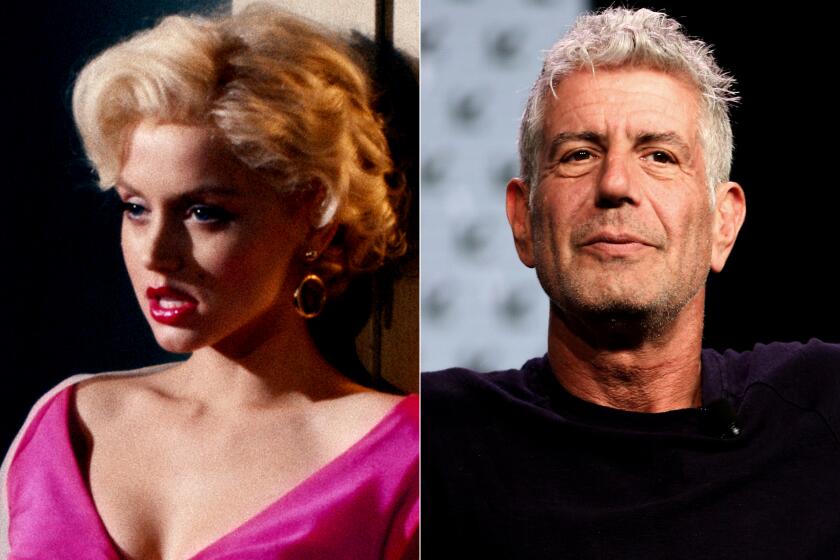Anthony Bourdain’s death has us asking the wrong questions about suicide

- Share via
A new unauthorized biography has many people talking again about the suicide of Anthony Bourdain in June 2018. As is often the case with people who die by suicide, much of the chatter includes questions such as: How did they do it? Who was the last person they talked to? What was different about that day? What was the precipitating event? We want to understand, and sometimes, we look for someone to blame.
Even Albert Camus, in his essay “The Myth of Sisyphus,” falls prey to this way of thinking, writing, “What sets off the crisis is almost always unverifiable. Newspapers often speak of ‘personal sorrows’ or of ‘incurable illness.’ These explanations are plausible. But one would have to know whether a friend of the desperate man had not that very day addressed him indifferently. He is the guilty one.”
But this way of thinking cheapens the death and struggles of anyone who has died by suicide or attempted it. Suicide, for most people, is a process. Sometimes that process starts at a very young age. The writer David M. Perry talks about his own suicidal ideation beginning at age 9. I have a former student who first attempted suicide by riding his tricycle through a window as a toddler. My own desire to kill myself is among my first memories.
We say we understand that mental illness is real, but when people with histories of depression, addiction or alcoholism die via suicide we wonder how it could happen.
Suicidal ideation can also be a regular part of a person’s life. The Australian podcaster Honor Eastly describes herself as thinking about suicide every day, sometimes dozens of times a day. Writers Margo Jefferson and Donald Antrim talk about what Jefferson refers to as suicide exercises. For Jefferson this meant putting her head in an oven for increasingly longer periods; for Antrim it meant laying out tarps on the floor of his apartment and lying there with a knife to slash his wrists or his throat. These experiences are not extreme for many suicidal people; they are typical. Anna Borges recently wrote about what we call “passive suicidal ideation”: not actively planning to kill herself, but fantasizing about it constantly, sometimes all day long.
Some of these people, like Jefferson, never make an attempt; some, like Antrim, make one attempt, survive and hopefully never try again. Others, like me, make multiple attempts, perhaps knowing that with every attempt one’s likelihood of dying by suicide significantly increases. There are those like David Foster Wallace, who make multiple attempts while also writing about and fighting the desire for death, who eventually do perish at their own hand. And there are the people like Bourdain who make only one attempt — so far as we know — and succeed. Yet no matter where one falls in terms of how they attempt, or contemplate, suicide, there are almost always warning signs — freak-outs, crises and big and small cries for help. Suicide is usually not an impulsive act that is one day or a few days in the making.
Nor is suicide inevitable, no matter how frequently a person thinks about it. Most deaths by suicide are avoidable and preventable with proper care, which need not necessarily come from a trained professional. One of the country’s leading experts on suicide, Dr. John Draper, project director of the National Suicide Prevention Lifeline network, told me that perhaps the most important thing to know about helping suicidal people is that “everybody can do it.”
“Explain that you are concerned, you care, you want to talk about it. Then whatever they tell you, just listen, reflect, be curious. Make no judgments. You might let them know that they can get through this.”
Suicide prevention and crisis counseling resources
If you or someone you know is struggling with suicidal thoughts, seek help from a professional and call 9-8-8. The United States’ first nationwide three-digit mental health crisis hotline 988 will connect callers with trained mental health counselors. Text “HOME” to 741741 in the U.S. and Canada to reach the Crisis Text Line.
How do we get through this? The ancient Stoics, who thought that suicide was morally justifiable in some circumstances, used to make an argument called “the door is always open.” The idea is, if things get that bad, you know you have a way out. But given that knowledge, suddenly even very painful situations are less claustrophobic. There’s no need to panic. You don’t have to go into fight or flight. You can breathe through this. Wait just one day.
We know that after famous people kill themselves, suicide rates increase. But talking about suicide is the best medicine we know of for helping suicidal people. For every one person who dies by suicide, about 280 people are presently considering it.
Humans are complicated, contradictory creatures, full of irrationality and cognitive and emotional dissonance. We are allowed to be both enormously grateful for life and desperate to escape it. The last unknown part that Bourdain showed us was just this: It’s OK to feel suicidal. It’s nothing to be ashamed of. Talk to someone about it. Talk to a few friends. They’ll remind you of what we wish we could have said to Anthony Bourdain that night. “Stick around, just for a day. We love you. Things may look much better in the morning.”
Clancy Martin is a writer and professor of philosophy at the University of Missouri in Kansas City and Ashoka University in New Delhi. His forthcoming book is “How Not to Kill Yourself: A Portrait of the Suicidal Mind.”
More to Read
A cure for the common opinion
Get thought-provoking perspectives with our weekly newsletter.
You may occasionally receive promotional content from the Los Angeles Times.










